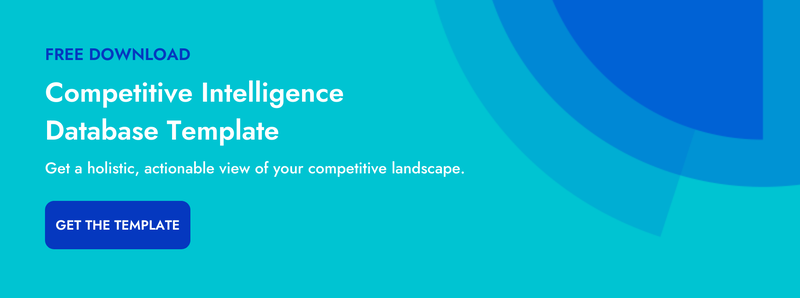Bootstrapping a hacky solution to a complicated competitive intelligence (CI) problem is enticing. But, as a company grows, free software trials and bootstrap fixes wear thin. Your limited investments in appropriate tools can become embarrassing.
One cannot expect reliable growth if nothing is invested. A $0.00 budget for a competitive intelligence program is not enough to see real value from your CI program. You may consider hiring a full-time CI professional to address the challenge. According to PayScale, a competitive intelligence analyst can earn upwards of $100,000 / year. Companies will bleed that salary if they leave employees equipped with lesser tools. Exactly what sort of tools, you ask?
Here are six hacky tools limiting your competitive intelligence program’s growth. Each comes with costs and consequences you might not be able to endure.
1) Spreadsheets Are Not a Sustainable Solution for Organizing Competitive Intelligence
We’re forced to ask, “Hey, are you good at Excel?” far too often. While skilled competitive intelligence professionals might be pivot table masters, they shouldn’t suffer a generic solution to a specific challenge. Anyone who has hacked together an Excel formula knows spreadsheets will become unwieldy as they grow. The spreadsheets will stunt the project’s scale and limit a competitive intelligence pro’s capabilities. The CI pro will struggle to deliver actionable data-driven takeaways.
Competitive intelligence professionals wish to prove value. Good ROI often comes in the form of a competitive sale won or a strategic decision made. Achieving this value-demonstration with a Google sheet would be nigh-impossible.
Platforms like Crayon are built for competitive intelligence. Crayon can connect your CI to your CRM, sales enablement platform, or even your internal chat program. Now you can begin understanding your intel’s value.
Cost: $0
Sales win / loss reports created: 0
 2) Note-taking Programs like Google docs or Evernote Will Break Down as More Users Come Aboard
2) Note-taking Programs like Google docs or Evernote Will Break Down as More Users Come Aboard
Consider the cleanliness of a blank Google document or a fresh instance of Evernote. Fresh potential quickly devolves. Good intentions and a focused competitive intelligence professional cannot succeed here. They need a real battlecards tool, not a blank page. It doesn’t matter if your foldering system is perfect. A CI pro might provide legible intelligence and update documents for a sales team if they are small and disciplined. It cannot last.
Platforms built for battlecards reveal your intel’s value with every sale. That value grows as your sales team grows. Quite the appealing alternative.
Cost: $0 (Evernote Business, $14.99 / user / month)
Customers won with battlecards: [REPORT PENDING]
3) Google News Alerts are an Unrefined Competitive Intelligence Solution
Wikipedia describes a Google News Alert as:
“Google Alerts is a content change detection and notification service, offered by the search engine company Google. The service sends emails to the user when it finds new results—such as web pages, newspaper articles, blogs, or scientific research—that match the user’s search term(s).”
The gathered Google News Alert articles are not, however, organized, tagged, or archived for future reference. They are not curated from reliable sources. The searches’ quality is not refined over time. Packaging and delivering these articles for internal use becomes shouting into the void.
Like the spreadsheets and documents, Google News Alerts are not a scalable solution. CI pros require refined news queries tailored to their stakeholders’ unique keyword and topic needs.
Cost: $0
Actionable news articles delivered to internal stakeholders: INCALCULABLE
4) Email Subscriptions and Newsletters Can’t Track Downloadable Offers
Categorizing the content your competitor distributes via email subscriptions, newsletters, and RSS is challenging. Competitive intelligence professionals will be back using a spreadsheet for links and targeted keywords. Multiply this problem by five or ten when you decide you need to track your chief competitors across an entire industry. What’s more, this method only surfaces their published content. Finding their whitepapers, ebooks, and other downloadables will be a separate task.
Proper competitive intelligence software can capture, analyze, and sort unique content types into a platform for simplified browsing. Now you won’t have extra trash in your inbox!
Cost: $0
Work-hours devoted to sluicing workable data from your competitors’ automated emails: COUNTLESS
5) Stock Social Media Tools Aren’t Worth the Time and Effort Searching for a Needle in the Haystack
Can you honestly glean meaningful insights from your daily glance at a Twitter feed? Maybe, if you followed only ten other accounts. Wade through the ads on Twitter. Dodge message notifications from your cousin on Facebook. You might find whether your competitors have published any meaningful content. Your competitors’ social media can often inspire your own campaigns. The ROI for competitive intelligence pros reading those social channels is too low.
Your team could still develop content in response, if done properly. Similar to the way CI platforms gather your competition’s content in a legible feed, most can also catch social media. But they take it a step further in finding trends in social media activity and surfacing that needle in the haystack that can inspire your next move.
Cost: $YOUR-EMOTIONAL-STABILITY-STARING-AT-TOO-MIUCH-SOCIAL-MEDIA
New blog topic ideas / week: ~2
6) Presentations / Slide Decks are a Competitive Intelligence Black Hole
Add this up and you’ll arrive at the crown jewel of hacky competitive intelligence delivery mechanisms: the slide deck. The slide deck is emblematic of a busted competitive intelligence program. It suggests all CI is presented like a catered lunch every so often to your department heads. In a best-case scenario, there’s at least meticulous intel in the slide presentation. It'll be viable in that moment. The deck is dated, distributed internally once, and posted to a repository, forgotten before 5PM.
Nobody will ever refer back to these slides. Weeks of work went into their creation. That time, effort, and money is now wasted.
Competitive intelligence as-a-book-report is not good enough. If your CI professionals are stuck preparing slide decks, you need a real-time CI platform to regularly capture, analyze, and present all your findings.
Cost: $100,000 / year
Embarrassment for money wasted [Actual Cost]: Priceless
Stop bootstrapping your competitive intelligence program. Stop hamstringing your employees’ growth potential. Instead, build a scalable CI program that allows you to discover and deliver actionable insights to each team throughout your company.

Related Blog Posts
Popular Posts
-
 The 8 Free Market Research Tools and Resources You Need to Know
The 8 Free Market Research Tools and Resources You Need to Know
-
 6 Competitive Advantage Examples From the Real World
6 Competitive Advantage Examples From the Real World
-
 24 Questions to Consider for Your Next SWOT Analysis
24 Questions to Consider for Your Next SWOT Analysis
-
 How to Create a Competitive Matrix (Step-by-Step Guide With Examples + Free Templates)
How to Create a Competitive Matrix (Step-by-Step Guide With Examples + Free Templates)
-
 How to Measure Product Launch Success: 12 KPIs You Should Be Tracking
How to Measure Product Launch Success: 12 KPIs You Should Be Tracking




